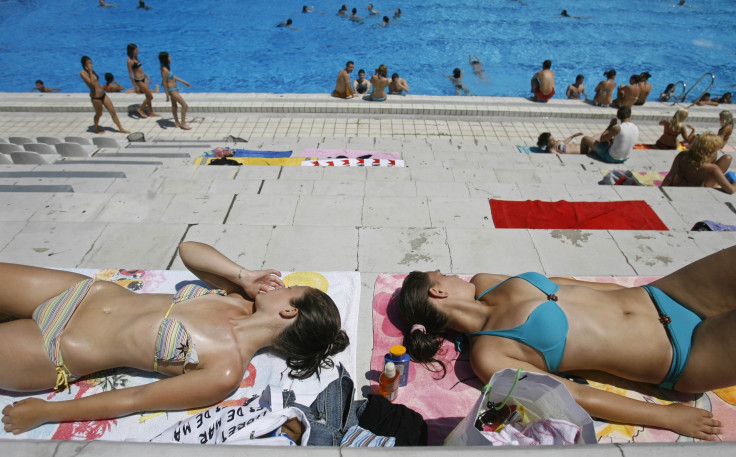What Do Sunscreen Numbers Mean? SPF Ratings, Brands And UV Rays Explained

The first day of summer has officially arrived, which means more Americans will be hitting the beach and laying poolside to beat the heat. While everyone needs a little sun exposure to get their annual vitamin D fix, too much sun can be dangerous. That’s where sunscreens come into play.
Choosing and using a sunscreen is critical for shielding you from the sun’s dangerous ultraviolet rays. Here’s an explanation of SPF ratings, the meaning behind all those numbers and ultraviolet radiation.
SPF And Sunscreen Ratings. A sunscreen’s SPF, or “sun protection factor,” refers to its ability to shield from the sun’s ultraviolet rays. It is a measure of the time it would take for a person to start getting red if he or she was not wearing sunscreen.
In general, it takes about 10 to 20 minutes without sunscreen for a person’s skin to start burning. An SPF 15 product would prevent skin from burning for 15 times longer – so about 150 to 300 minutes, or about 2.5 to five hours. However, that doesn’t mean you’re fully protected for that five hours. Dermatologists highly recommend reapplying sunscreen every two to four hours, as sunscreen can rub off or get washed off in the water.
For many, such numbers can get confusing. "SPF is not a consumer-friendly number," Florida dermatologist James Spencer told WebMD. "It is logical for someone to think that an SPF of 30 is twice as good as an SPF of 15 and so on. But that is not how it works."
A sunscreen with an SPF 15 blocks about 94 percent of the sun’s dangerous rays. SPF 30 products block about 97 percent of such rays, and SPF 45 sunscreen shields against about 98 percent of rays. There’s really no need to go any higher, said Spencer.
Sunscreen Brands. Banana Boat, Coppertone Sport, sheer protection and continuous spray – there are endless sunscreen brands on the market and even more ways to apply them, but aren’t they all the same?
Not exactly. Some brands are better than others in terms of the range of ultraviolet radiation they protect against. More brands in recent years have broad-spectrum or multi-spectrum protection, meaning they shield against more than one type of ultraviolet radiation. Look for brands with those descriptions.
Also, consider sunscreens with “waterproof” or “water-resistant” on their labels, especially if you plan to go swimming or be active.
When it comes to choosing a sunscreen, consider any allergies you may have. “Sunscreens use a variety of chemicals that work to absorb harmful UV rays before they penetrate your skin,” according to cancer expert Lisa Fayed. “Some people are sensitive or allergic to certain ingredients, like PABA, and choose to use sunblock instead of sunscreen. In fact, many brands today are a blend of sunscreen and sunblock, so it’s important to check the label if you have a sensitivity to certain chemicals.”
Ultraviolet Radiation. They’re invisible, but the damage they can cause to your skin and health is anything but subtle. Ultraviolet, or UV, radiation comes from the sun and is just one of the forms of energy that reach earth’s surface. UV radiation is a combination of UVA, UVB and UVC rays. UVA rays are the number one cause of long-term skin damage, including wrinkles and skin cancer.
UVB rays can damage skin cells at a molecular level and are the main cause of sunburns, according to the American Cancer Society. They also cause most forms of skin cancer. UVC rays do not pass through earth’s atmosphere.
UV rays are strongest during the spring and summer and are most intense between 10:00 a.m. and 4:00 p.m. And just because there’s cloud cover, doesn’t mean you can’t get burned. Some 80 percent of the sun’s UV radiation can pass through clouds.
© Copyright IBTimes 2025. All rights reserved.






















